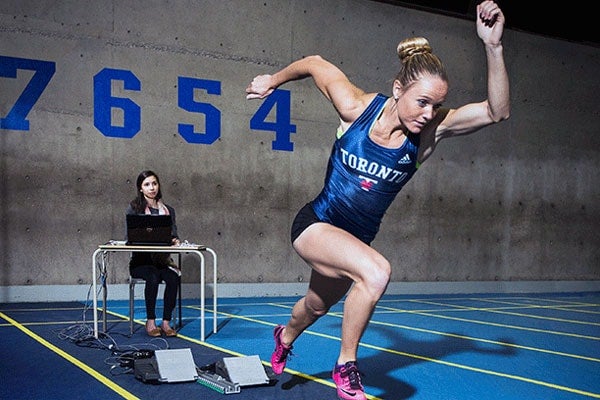
Toronto 2015 Pan Am/Parapan Am Games: the science of sprinting
Published: April 17, 2015
For University of Toronto Olympian and Toronto 2015 Pan Am/Parapan Am Games hopeful Sarah Wells, few athletic moments are as rife with anticipation as those leading up to when she places her feet on the starting blocks.
“Your start sets up your entire race,” Wells explains. “When you have a great start, you've already done the work early and can carry that momentum forward. It makes it more likely that you will reach your top end speed and that's what track and field is all about – who can run the fastest and the longest.”
Bob Westman, sprints coach for the Varsity Blues track and field team, agrees. “A good start can make or break an athlete’s performance during a big race.”
Master’s student Lindsay Musalem is working with Pan Am-bound track athletes, Westman and Blues sprinters to optimize their starts, using custom-made force plates that have been affixed to training start blocks.
The equipment came from Own the Podium and has been used at the Canadian Sport Institute Ontario at the Pan Am Centre. Here at U of T they are being used for the first time to gather data during practice and training sessions.
“My thesis focuses on whether or not athletes can consistently reproduce the same start, using the force plates,” Musalem explains. “So we’re going into multiple practices and training sessions with the same athletes to see if, over time, they are able to reproduce strong starts.”
Musalem, who is supervised by Professor Tyson Beach, is measuring not only how quickly the athletes are getting off the start blocks, but also how much force is being exerted on to the plate and back at the athlete and all directions, forwards and back, side-to-side and vertically.
With the data gathered by the force plates, Musalem is able to see which direction the athletes are pushing in. In theory, the sprinter should push straight in the horizontal direction to get off the blocks as efficiently as possible.
What makes a good start for a sprinter from UofT Kinesiolgy & Phys Ed on Vimeo.
“You don’t want the athletes creating extraneous forces that aren’t going to help them get out of the blocks,” Musalem explains.
The challenge for the athletes and coach is to find a balance between the horizontal and the vertical because obviously they are coming out of the blocks with their torso over their body so they want to achieve balance while not falling over.
“A good sprint start is kind of a controlled fall,” says Musalem.” It’s attempting to maximize the horizontal while staying upright.”
Westman has found the research to be helpful in developing more informed coaching techniques. “It’s great because we get real time results that we can take back to our offices to analyze and apply to training.”
Wells, who competes in the 400 metre hurdles, appreciates the benefits that sport science-informed training can provide.
“One of the benefits to training at U of T is the research like Lindsay’s,” says Wells. “It helps me find that extra edge.”
See sport science and technology converge live on May 12 at From Good to Gold.
Read more about the Toronto 2015 Pan Am/Parapan Am Games.
Valerie Iancovich is a writer with the Faculty of Kinesiology & Physical Education at the University of Toronto.



